Overview
Augmented reality in retail significantly enhances customer engagement and purchasing confidence by seamlessly merging digital elements with physical shopping experiences. This innovative technology empowers consumers to visualize products within their own environments, fundamentally transforming the shopping experience.
Research indicates that such advancements lead to substantial increases in conversion rates and notable reductions in return rates. Successful implementations, such as IKEA's Place app and Sephora's Virtual Artist, serve as prime examples of this transformative impact on the retail landscape.
Brand managers are encouraged to explore these proven strategies to leverage augmented reality, ultimately fostering greater collaboration and driving business growth.
Introduction
The retail landscape is experiencing a profound transformation, propelled by the integration of augmented reality (AR) technology that seamlessly blends digital and physical shopping experiences. This innovative strategy not only elevates customer interaction but also fundamentally alters how consumers visualize products, resulting in more informed purchasing decisions. As AR technology gains traction, a pivotal question emerges: how can retailers effectively harness this technology to align with the evolving expectations of tech-savvy shoppers while navigating the inherent challenges of implementation?
Defining Augmented Reality in Retail
The concept of augmented reality in retail represents a transformative fusion of digital information with the physical purchasing environment, significantly enhancing user interaction through immersive elements. This technology overlays computer-generated images, sounds, and sensory stimuli onto the real world, enabling customers to visualize products in a more engaging manner. For instance, AR allows shoppers to see how furniture fits in their homes or how clothing looks without the necessity of physical try-ons. This blend of digital and physical interactions revolutionizes conventional retail into a vibrant and customized journey.
The impact of augmented reality in retail is both profound and undeniable. Industry leaders predict that by 2025, a substantial segment of consumers will routinely engage with AR, solidifying its status as a standard component of the shopping process. Notable implementations, such as IKEA's Place app, empower users to visualize furniture in their spaces, achieving a remarkable 98% accuracy in size representation while effectively reducing return rates. Similarly, brands like Sephora have harnessed AR through their Virtual Artist app, which has recorded over 200 million makeup trials, resulting in increased online sales and diminished return rates.
Magic Playbox is at the forefront of this transformation, pioneering immersive AR and XR interactions that enhance brand engagement and foster customer loyalty. By integrating AR solutions into shopping environments, Magic Playbox assists brands in crafting interactive experiences that resonate with tech-savvy consumers.
Experts assert that augmented reality in retail not only enhances product visualization but also significantly boosts purchase confidence. Research indicates that products featuring AR content experience conversion rates up to 94% higher than those without. As augmented reality in retail technology continues to advance, it is set to become as integral to shopping as mobile apps, fundamentally altering how consumers interact with brands and products. This shift underscores the imperative for retailers to adopt augmented reality in retail solutions, such as those offered by Magic Playbox, to remain competitive and meet the escalating expectations of tech-savvy shoppers.
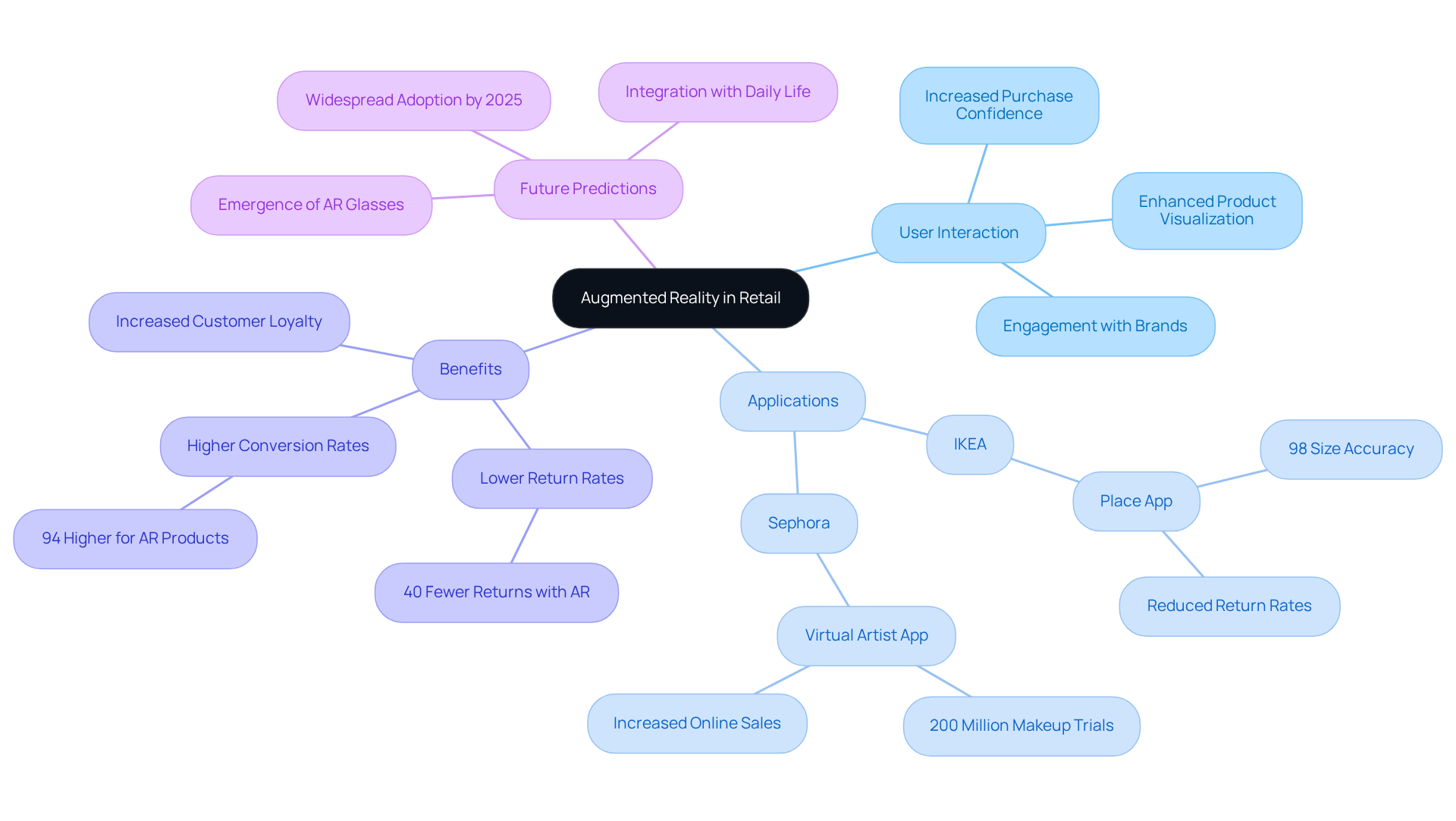
The Evolution of Augmented Reality in Retail
The evolution of augmented reality (AR) in commerce commenced in the early 2000s, a period when the technology began to gain traction, albeit in limited and experimental forms. Initially, applications primarily focused on simple overlays. However, the landscape shifted dramatically with advancements in mobile technology and computer vision. A pivotal moment emerged in 2017 with the launch of IKEA's 'IKEA Place' app, which empowered users to visualize furniture within their own homes. This marked a significant milestone in the journey of augmented reality in retail.
As AR technology has matured, its applications have broadened significantly. Retailers now leverage AR for virtual try-ons, allowing shoppers to see how clothing or cosmetics would appear on them without the need for physical trials. Interactive displays have become prevalent, enhancing in-store interactions by engaging shoppers in innovative manners. Furthermore, customized shopping experiences are increasingly facilitated through AR, effectively bridging the gap between digital and physical interactions.
Magic Playbox has been at the forefront of this evolution, pioneering immersive AR and XR interactions that enhance brand engagement and foster customer loyalty. Experts predict that as augmented reality in retail progresses, it will become a vital component of everyday commerce, fundamentally transforming how consumers shop and engage with brands. Tim Cook emphasizes that a substantial segment of the population will encounter AR daily, akin to the widespread use of smartphones. This indicates that the future of commerce will be intricately connected to augmented reality in retail.
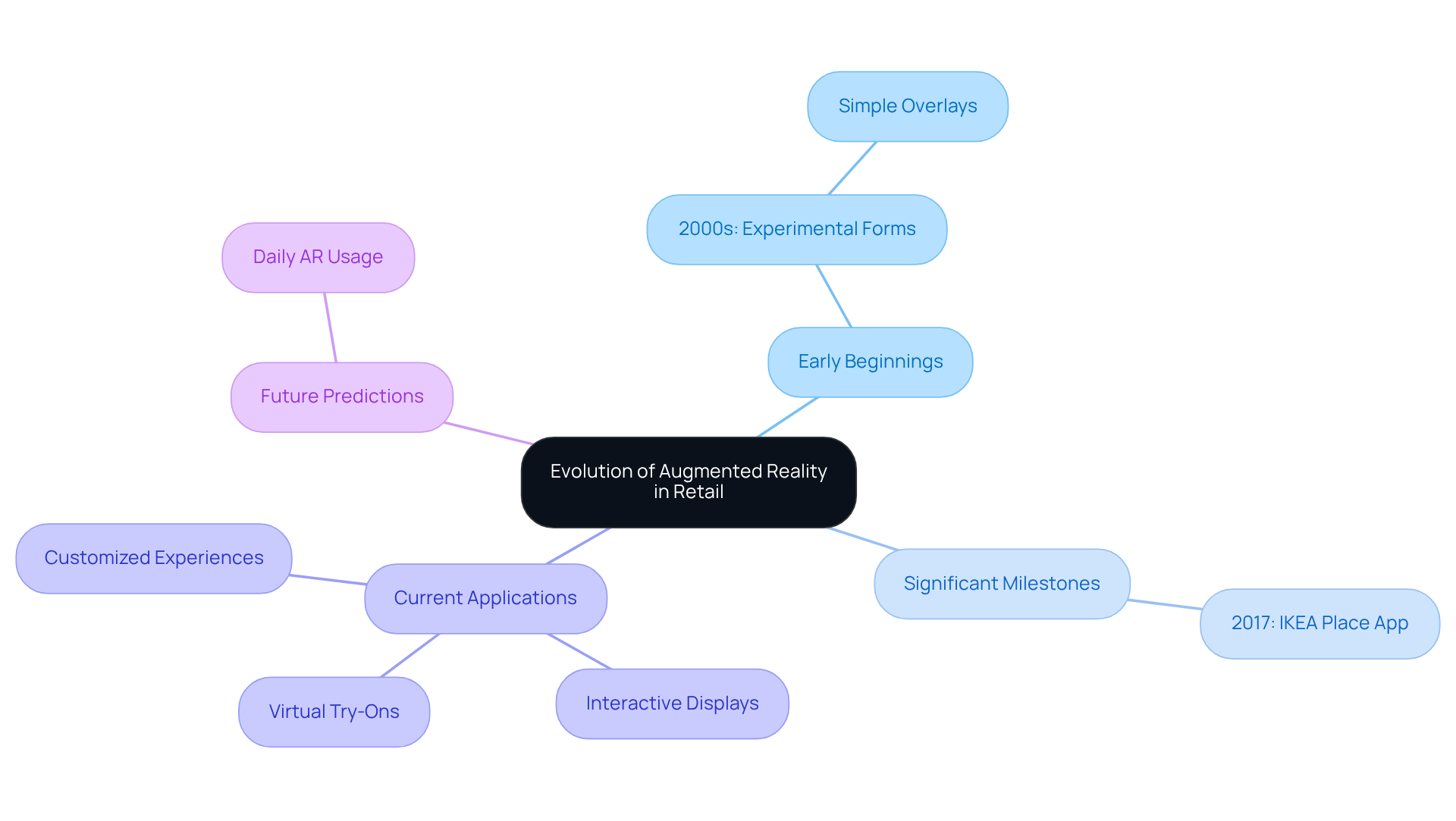
Applications of Augmented Reality in Retail
Augmented reality in retail is revolutionizing the industry with diverse applications such as virtual fitting rooms, product visualization, and interactive marketing campaigns. Notably, beauty companies like L'Oréal have successfully implemented AR applications that allow customers to virtually test makeup, enhancing the purchasing process and boosting confidence in their acquisitions. In the fashion sector, retailers are leveraging AR technology to enable shoppers to see how clothing fits in real-time, significantly reducing the uncertainty often associated with online shopping.
Research indicates that:
- 61% of consumers favor retailers that offer augmented reality in retail interactions
- 71% would shop more frequently if they could utilize augmented reality in retail
This technology not only enhances customer satisfaction but also drives sales; brands employing augmented reality in retail have reported a remarkable 2.5 times increase in sales. Furthermore, augmented reality in retail enhances in-store experiences through interactive displays that deliver product information and promotions, creating a more engaging shopping environment.
Case studies further illustrate the effectiveness of AR in retail. For instance, the IKEA Place app empowers users to visualize how furniture would appear in their homes before making a purchase, leading to more informed buying choices and heightened sales. Similarly, brands like Rebecca Minkoff have observed that clients are 27% more inclined to place an order after viewing a product in 3D, underscoring the substantial impact of AR on conversion rates.
As we approach 2025, the augmented reality in retail sector is projected to reach $12 billion, underscoring the increasing significance of AR technologies in enhancing user interactions and driving sales. By incorporating AR into commerce strategies, companies can create immersive shopping experiences that not only meet but exceed client expectations.
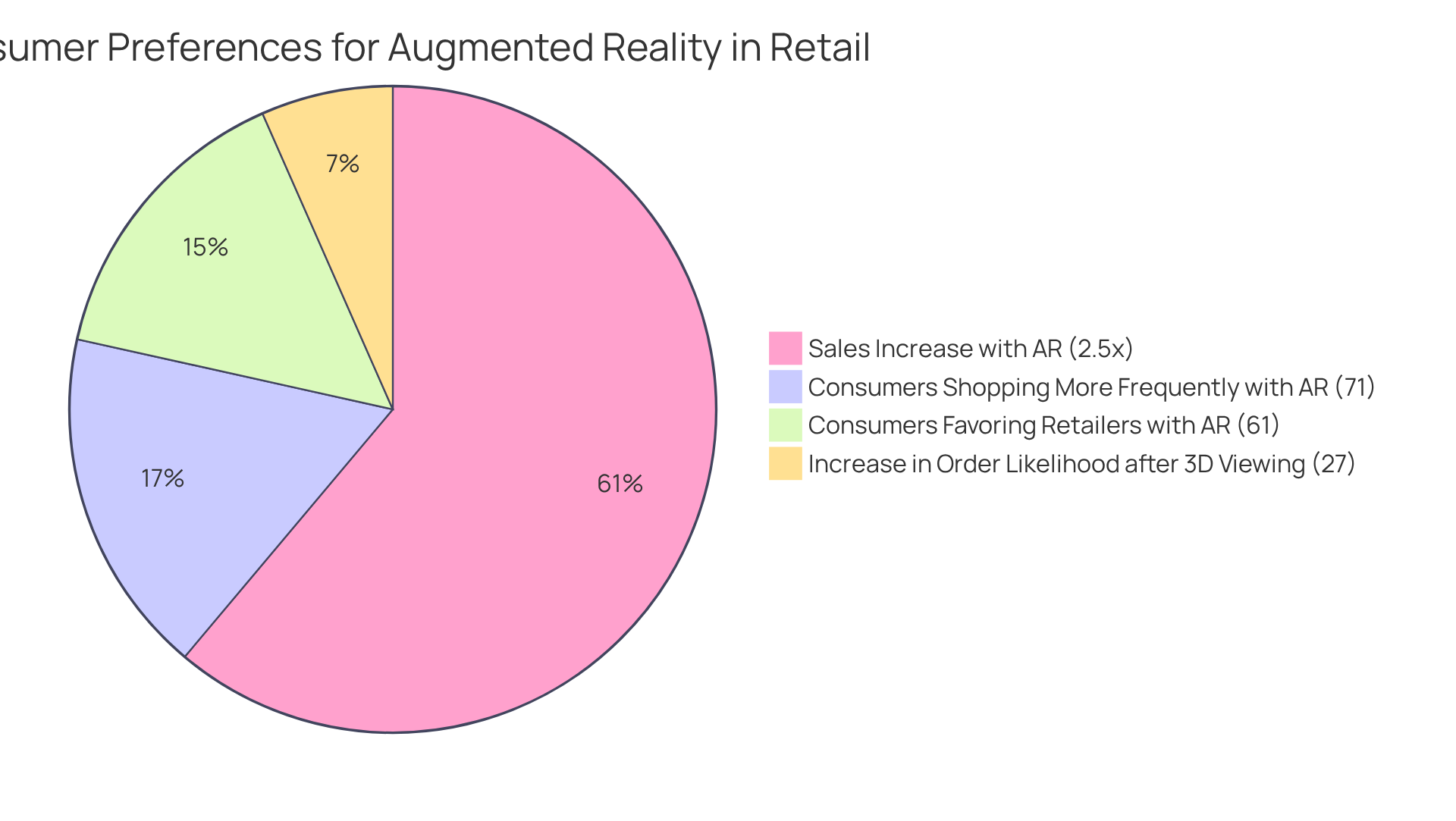
Benefits of Augmented Reality for Retailers and Customers
The integration of augmented reality in retail presents a multitude of advantages for both retailers and consumers, particularly through the innovative solutions offered by Magic Playbox. AR significantly boosts conversion rates; research indicates that products featuring AR content can experience conversion rates increase by up to 94%. This technology also plays a crucial role in reducing return rates. For instance, Macy's reported that AR visualizations for furniture led to return rates dropping to under 2%, compared to the typical 5-7%. Furthermore, AR enhances customer engagement, with reports indicating that brands utilizing AR storefronts achieve up to 11 times higher engagement compared to traditional displays. Magic Playbox's innovative AR solutions illustrate this trend, offering engaging interactions that captivate consumers and boost sales.
For consumers, AR transforms the purchasing process into a more engaging and customized journey. It enables shoppers to visualize products in their own environments, fostering confidence in their purchasing decisions. Studies show that 98% of users consider AR beneficial for making purchase choices, and 75% of consumers who have utilized AR in retail report increased satisfaction levels. This improved experience not only boosts immediate sales but also fosters long-term loyalty, as individuals feel more connected to brands that provide innovative shopping solutions, such as those created by Magic Playbox.
As we approach 2025, the advantages of AR for merchants are anticipated to grow further. Gartner forecasts that 80% of brand names will integrate AR into their customer engagement strategies. This change underscores the significance of AR in fulfilling contemporary consumer expectations and enhancing overall satisfaction, ultimately positioning sellers at the forefront of the commercial revolution. Mickey Toogood, Sr. has been a strong advocate for the use of augmented reality in retail. The Content Marketing Manager at Amazon observes that augmented reality in retail is transforming the industry by creating more immersive, efficient, and fulfilling shopping encounters. Furthermore, WebAR is poised to evolve into a valuable marketing instrument, enabling seamless incorporation of AR into current customer interactions and engaging 2-3 times more users than app-based alternatives. Magic Playbox is leading this evolution, spearheading the creation of engaging AR experiences that resonate with consumers.
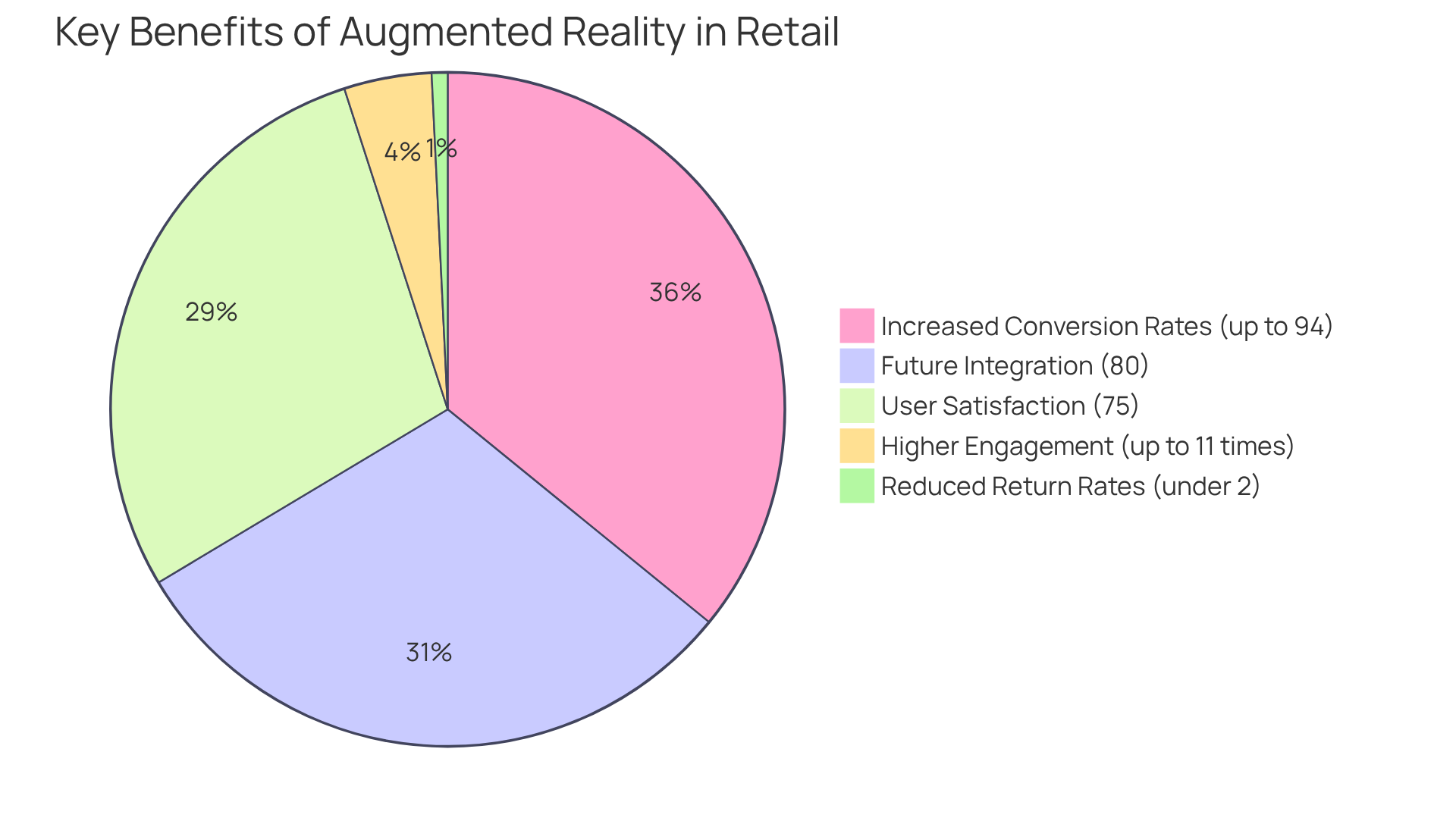
Challenges and Future Directions of Augmented Reality in Retail
The implementation of augmented reality in retail presents several challenges that retailers must navigate. Technical hurdles, such as the necessity for robust infrastructure and seamless integration with existing systems, can impede progress. Moreover, both employees and clients may encounter a learning curve as they adjust to these new technologies. Research indicates that financial constraints and a lack of C-level buy-in are significant barriers to AR adoption. Notably, 56% of retailers are planning new AR/VR investments by 2025 to enhance customer engagement and drive sales.
Despite these challenges, the future of augmented reality in retail is promising. Industry leaders predict that augmented reality in retail will become a mainstream tool, with projections estimating the market for augmented reality in retail to reach $12 billion by 2025. Retailers are anticipated to explore more advanced applications, including AI-driven augmented reality interactions that offer tailored suggestions based on buyer behavior. Successful case studies, such as IKEA's Place app, illustrate how AR can boost consumer confidence and lower return rates by enabling individuals to visualize products in their own environments.
Furthermore, brands utilizing AR storefronts report up to 11 times higher engagement compared to static displays, indicating a significant shift in consumer interaction. As AR technology becomes more accessible, augmented reality in retail is poised to play a crucial role in transforming the future of retail interactions, bridging the gap between online and offline shopping. Retailers that strategically invest in AR will not only enhance client satisfaction but also position themselves as innovators in a rapidly evolving market. Importantly, 61% of consumers prefer retailers that offer augmented reality in retail experiences, which underscores the growing demand for this technology. Additionally, AR technology can help reduce high return rates by enabling customers to make well-informed decisions, addressing a critical challenge for retailers.
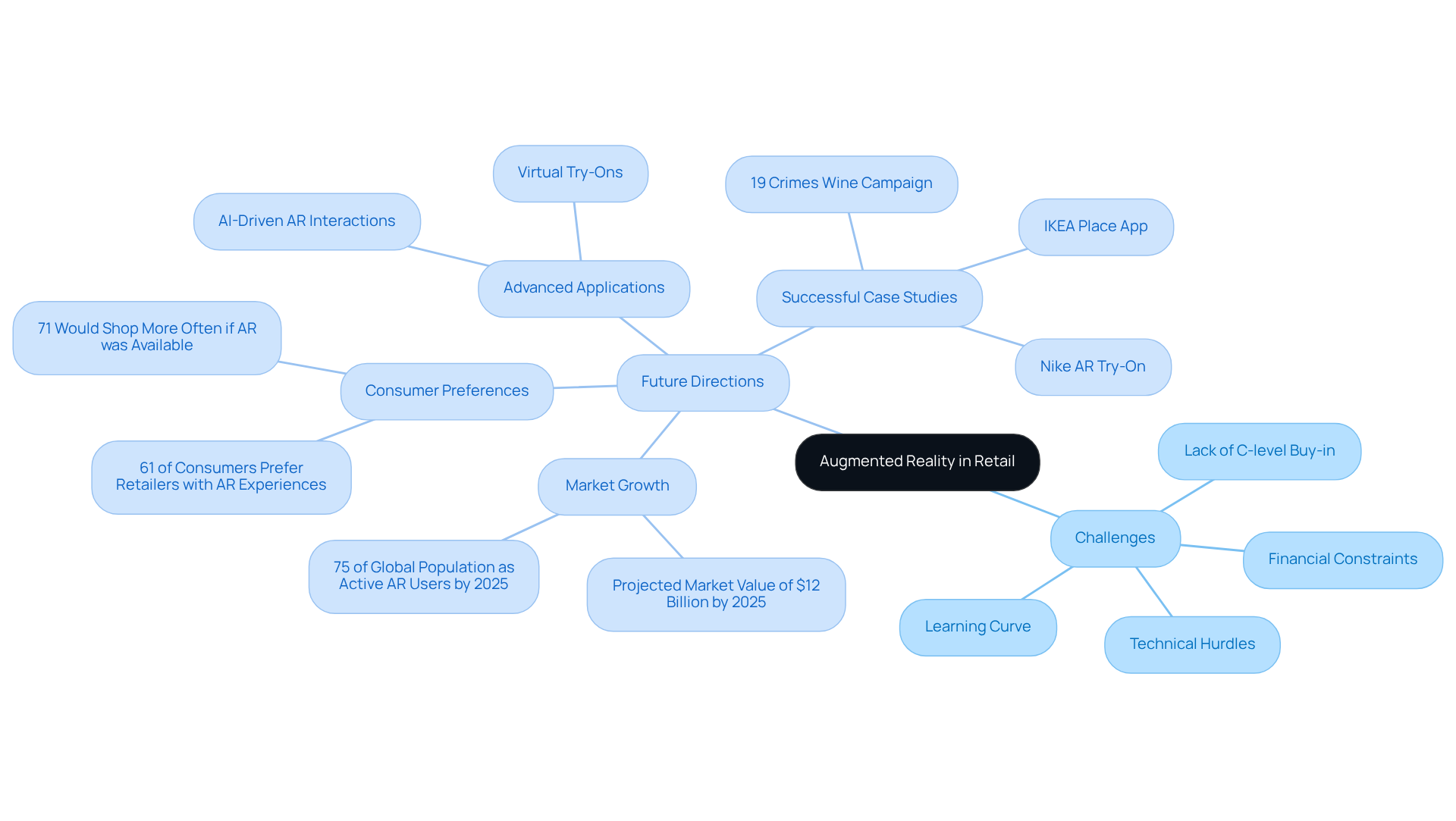
Conclusion
The integration of augmented reality in retail marks a significant advancement in how consumers interact with products and brands. By blending digital elements with the physical shopping experience, augmented reality not only enhances product visualization but also transforms the purchasing journey into a more immersive and personalized encounter. As this technology continues to evolve, it is poised to become a cornerstone of the retail landscape, fundamentally changing customer expectations and engagement.
Key insights reveal the profound impact of augmented reality on retail dynamics. Notable applications such as IKEA's Place app and Sephora's Virtual Artist illustrate the technology's potential. Impressive statistics indicate higher conversion rates and reduced return rates, underscoring the necessity for retailers to adopt AR solutions. The benefits extend beyond sales; consumer satisfaction and loyalty are significantly enhanced as shoppers embrace the innovative experiences that AR provides.
Looking ahead, the future of augmented reality in retail is bright, with projections indicating substantial market growth. Retailers are encouraged to invest in AR technologies not only to stay competitive but also to meet the evolving demands of tech-savvy consumers. By harnessing the power of augmented reality, businesses can create engaging shopping experiences that resonate deeply with customers, ultimately shaping the future of retail in a rapidly changing marketplace.
Frequently Asked Questions
What is augmented reality in retail?
Augmented reality in retail is the integration of digital information with the physical shopping environment, enhancing user interaction through immersive elements. It overlays computer-generated images, sounds, and sensory stimuli onto the real world, allowing customers to visualize products more engagingly.
How does augmented reality enhance the shopping experience?
AR enhances the shopping experience by enabling customers to see how products, like furniture or clothing, fit into their personal spaces without needing physical try-ons. This technology creates a more vibrant and customized shopping journey.
What are some examples of augmented reality applications in retail?
Notable examples include IKEA's Place app, which allows users to visualize furniture in their homes with 98% accuracy, and Sephora's Virtual Artist app, which has facilitated over 200 million makeup trials, increasing online sales and reducing return rates.
What impact is augmented reality expected to have on consumer behavior by 2025?
Experts predict that by 2025, a significant portion of consumers will regularly engage with AR in their shopping processes, making it a standard component of retail.
How does augmented reality affect purchase confidence?
Augmented reality significantly boosts purchase confidence, with research indicating that products featuring AR content experience conversion rates up to 94% higher than those without.
What role does Magic Playbox play in augmented reality for retail?
Magic Playbox is a leader in pioneering immersive AR and XR interactions, helping brands enhance customer engagement and loyalty by integrating AR solutions into shopping environments.
How has augmented reality evolved in retail since its inception?
The evolution of AR in retail began in the early 2000s with simple overlays, but it has advanced significantly due to mobile technology and computer vision. A key milestone was the launch of IKEA's 'IKEA Place' app in 2017, leading to broader applications like virtual try-ons and interactive displays.
What does the future hold for augmented reality in retail?
The future of augmented reality in retail is expected to be integral to everyday commerce, fundamentally transforming how consumers shop and interact with brands, similar to the widespread use of smartphones.




